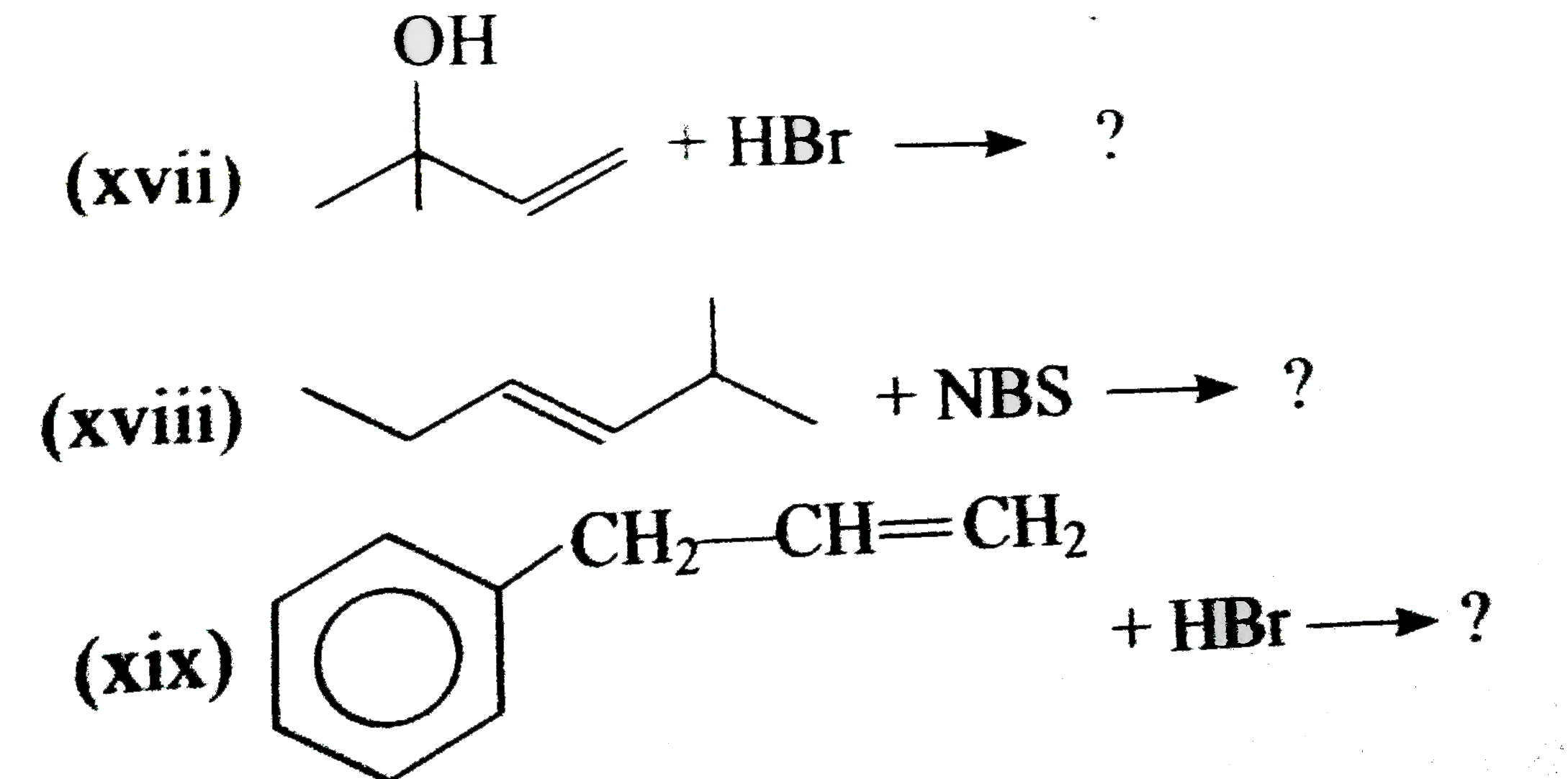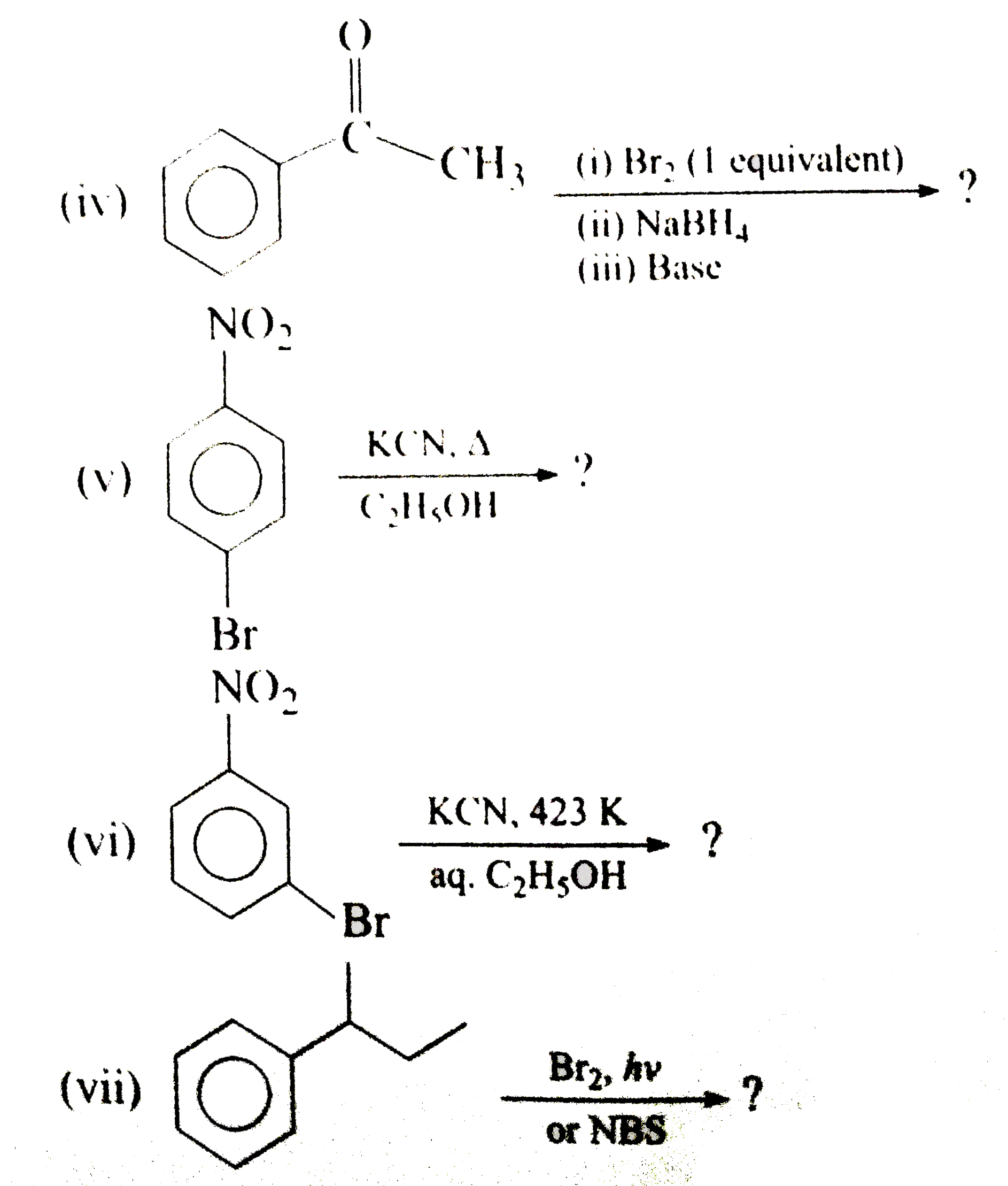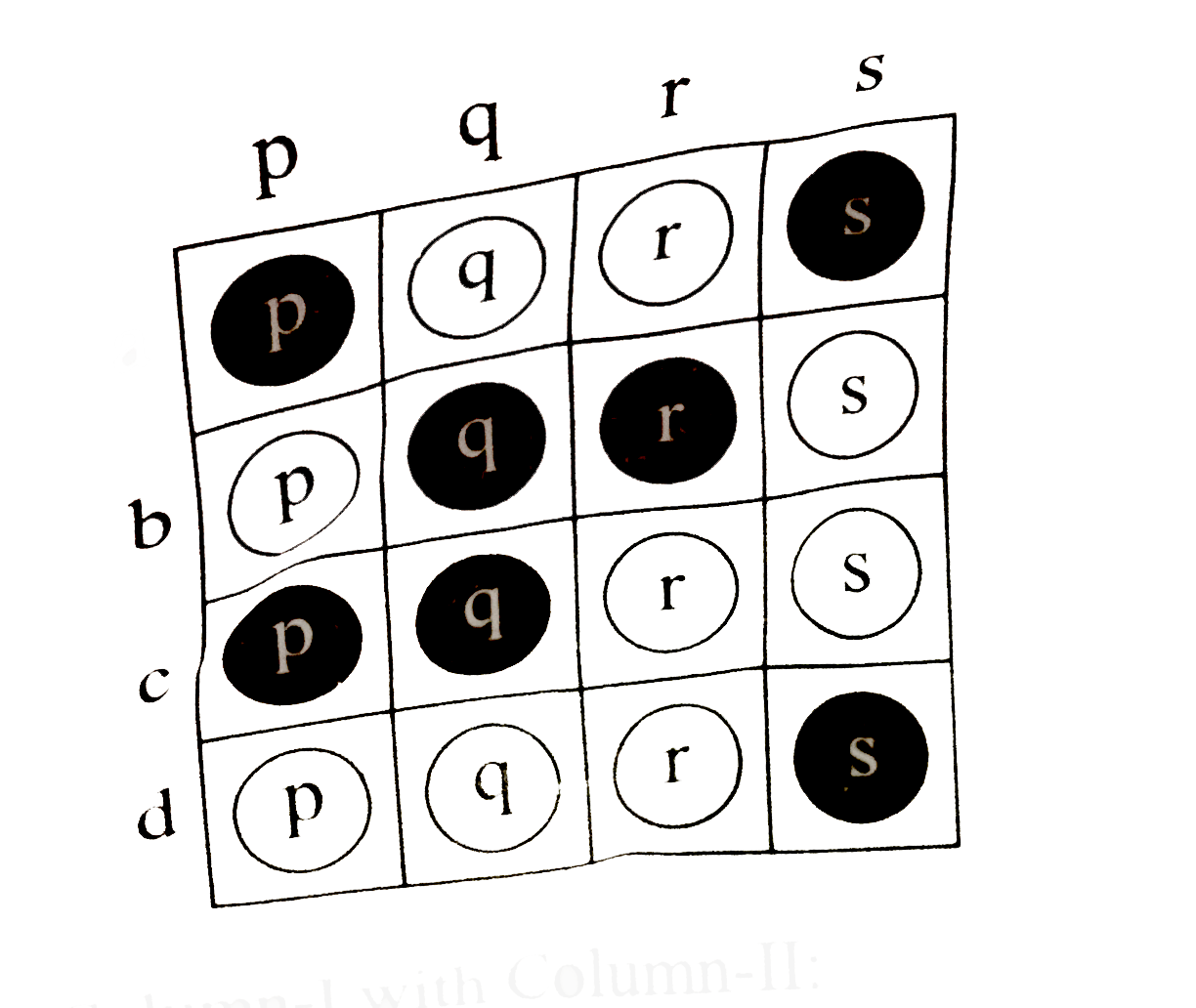(a) Indicate whether the following are SN1,SN2,E1 or E2 reactions.
(i)CH3CH2CH2CI+I−→
(ii)(CH3)3CBr+CN−(alc.)→
(iii)CH3CH(Br)CH3+OH−(alc.)→
(iv)(CH3)3C−Br+H2O→
(b) Give the decreasing order of reactivity of the alkaline hydrolysis of the following alkyl halides toward (A)SN1(B)SN2(C) in pressure of AgNO3.
(i)(CH3)2C(Br)−C2H5(ii)C5H11Br
(iii)C2H5CH(Br)C2H5
(c) Give the decreasing order reactivity of the alkaline hydrolysis of hte following halides towards SN1(i)MeCI(ii)PhCH2CI(ii)Ph2CHCI(iii)Ph3C−CI.
(d) Determine the relative SN2 reactivity with NaCI in aprotic DMSO of the following alkyl halides :
(A)(i)CH3CHCICH2CH3(ii)CH3CHBrCH2CH3
(iii)CH3CHICH2CH3
(B)(i)CH3CH(CH3)CH2CH2I
(ii)CH3CH(CH3)CHICH3(iii)CH3CI(CH3)CH2CH3
(e) Arrange the following in the order of decreasing nucleophilic character:
H2O,−OH,CH3O−,CH3COO−
(f) Arrange the following in the decreasing order as leaving group in SN reaction:
CH3COO−,C6H5O−,C6H5SO−3,CH3O−
(a)(i)CH3CH2CH2−I is SN2 reaction (1∘halide and I− is a good nucleophile and poor base.
(ii)CH3CH=CH2 is E2 reaction, less polar solvent favours E2.
(iv)(CH3)3C−OH is SN1 reaction as H2O is not basic enough to remove a proton to give elimination reaction.
(b)(A)(i)>(iii)(3∘>2∘>1∘ alkyl halides )SN1.
(B)(ii)>(iii)>(i)(1∘>2∘>3∘ alkyl halides)SN2.
(C)(i)>(iii)>(ii): Heavy ions such as Ag+ or Pb2+ catalyse SN1.
(C)(iv)Ph3C−CI>(iii)Ph2CH−CI>(ii)PhCH2−CI>(i)NeCI.
(d)(A)(iii)>(ii)>(i)(Group leaving ability is I−>Br−>CI−)
(B)(i)>(ii)>(iii)(steric factor makes the reactivity 1∘>2∘>3∘).
(e) When the nucleophilic centre is same . The nucleophilicity is same as basic character.
Acidic character :H3O+>CH3COOH>CH3OH>H2O.
Basicity and nucleophilicity : H2O<CH3COO−<CH3O−<OH−.
(f) Weaker the base or stronger the acid, better is the leaving group.
Acidic character : C6H5SO3H>CH3COOH>C6H5OH>CH3OH.
Topper's Solved these Questions
- HALOALKANES AND HALOARENES Book:OP TANDONChapter:HALOALKANES AND HALOARENES Exercise:Problem For Practice
Explore 19 Videos
- HALOALKANES AND HALOARENES Book:OP TANDONChapter:HALOALKANES AND HALOARENES Exercise:Matching type
Explore 2 Videos
- HALOALKANES AND HALOARENES Book:OP TANDONChapter:HALOALKANES AND HALOARENES Exercise:illustrations of objective questions
Explore 10 Videos
- ELECTROCHEMISTRYBook:OP TANDONChapter:ELECTROCHEMISTRYExercise:Matrix-Matching Type Question
Explore 3 Videos
- ISOMERISM (STRUCTURAL AND STEROISOMERISM)Book:OP TANDONChapter:ISOMERISM (STRUCTURAL AND STEROISOMERISM)Exercise:INTEGER
Explore 7 Videos
Similar Questions
(A) What is the final product in each reaction?
(i)C2H5OHI2−−−−−−→NaOH
(ii)CHCI3Ag−−−−−→Heat?
(iii)CHCI3HNO3−−−→?
(iv)CI4Fe/H2O−−−−→?
(v)C6H5NH2CHCI3−−−−−→KOH?
(vi)C4H9BrNaNO2/C2H5OH−−−−−−−−−−→?

(ix)CH3LiCH2=CH2−−−−−−→?
(x)(CH3)3CCI(CH3)2Zn−−−−−−→?
(xi)H2C=CH3∣C−CH2CH3IBr−−→?
(xii)CH3−CH−CH2NBS−−→?
(xiii)CH3−C∣CH3H−CH2CINaI−−−−−−−−−→Acetone,Δ?
(xiv)R3MgX(CH3)2CO/H2O−−−−−−−−−−→?
(xv)CH3−C∣BrH−C∣CH3H−CH3+HBr→?
(xvi)CH3−C∣CH3H−C∣OHH−CH3+HBr→?

(xx)CH3−CH3∣C∣CH3−C∣CIH−CH3+KOH(alc)→?
(xxi)(CH3)3C−CH2Br+KOH(alc)→?
(xxii)CH3−CH3∣C∣CH3−CH2Br+C2H5OHHeat−−→?

(B)(i)C6H5CH2CH3Br2−−−−−→hv?
(ii)C6H5CH2CH3(i)Br2,heat ,light−−−−−−−−−−−−−−→(ii)NaCN,H2O/H?
(iii)CICH2CH2CH2COPhKOH−−−−−−→MeOH?


View SolutionMatch the following :
(i) (A)carbon tetrachloride1.Antiseptic(B)Chloretone2.Refrigerant(C)Westrosol3.Chloroform(D)Freon4.Polymer(E)Iodoform5.Hypnotic(F)Teflon6.Pyrene(G)Carbylamine reaction7.Solvent
(ii) (A)Acetone1.Plastic(B)Chloropicrin2.Gem-dihalide(C)PVC3.Vic-dihalide(D)RCHCI24.Iodoform test(E)CH2CI−CH2CI5.Grignard reagent(F)RMgX6.CHCI3+HNO3
View SolutionOn monochlorination of 2-methylbutane, the total number of chiral compound formed is :
View SolutionThis section contains 3 questions. Each question contains statement given in two columns which have to be matched. Statement (a, b, c and d) in Column-I have to be matched with statement (p, q, r and s) in Column-II. The answers to these questions have to be appropriately bubbled as illustrated in the following examples :
If the correct matches are (a-p, s), (b-q, r), (c-p, q) and (d-s), then correct bubbled 4×4 matrix should be as follows:

Match the column-I with Column-II :

View SolutionWrite the total number of cyclic structural as well as stereosiomers possible for a compound with the molecular formula C5H10.
View SolutionPredict the order of reactivity of the following compounds in SN1 and SN2 reactions:
(i) The four isomeric bromobutanes
(ii) C6H5CH2Br,C6H5CH(C6H5)Br,C6H5CH(CH3)Br,C6H5C(CH3)(C6H5)Br
View SolutionName the following halides according to IUPAC system and classify them as alkyl, allyl, benzyl (primary, secondary, tertiary), vinyl or aryl halides: (i) (CH_(3))_(2)CHCH(Cl)CH_(3) , (ii) CH_(3)CH_(2)CH(CH_(3))CH(C_(2)H_(5))Cl (iii) CH_(3)CH_(2)C(CH_(3))_(2)CH_(2)I , (iv) (CH_(3))_(3)C CH_(2)CH(Br)C_(6)H_(5) (v) CH_(3)CH(CH_(3))CH(Br)CH_(3) , (vi) CH_(3)C(C_(2)H_(5))_(2)CH_(2)Br (vii) CH_(3)C(Cl)(C_(2)H_(5))CH_(2)CH_(3) , (viii) CH_(3)CH=C(Cl)CH_(2)CH(CH_(3))_(2) (ix) CH_(3)CH=CHC(Br)(CH_(3))_(2) (x) p-ClC_(6)H_(4)CH_(2)CH(CH_(3))_(2) (xi) m-ClCH_(2)C_(6)H_(4)CH_(2)C(CH_(3))_(3) , "(xii)" o-Br-C_(6)H_(4)CH(CH_(3))CH_(2)CH_(3)
View SolutionHow many of the following alkyl halides would react by SN1 mechanism?
CH3Br,CH3CH2Br,CH3CH2CH2I,(CH3)3CBr,BrCH3CH=CH2,C6H5CH2Br,(CH3)3CCH2Br,C6H5CHBrCH3,CH3CH=CHCH2Cl.
 .
.
View SolutionThe SN1 reactivity of the following halides will be in the order:
(i) (CH3)3C−Br
(ii) (C6H5)CHBr
(iii) (C6H5)2C(CH3)Br
(iv) (CH3)2CHBr
(v) C2H5Br
View SolutionIUPAC पध्दति के अनुसार निम्न हैलाइडो का नामकरण कीजिए तथा उन्हें ऐल्किल, ऐलाइल, बैंजीन (प्राथमिक, द्वितीयक, तृतीयक) फेनिल अथवा ऐरील हैलाइडो मे वर्गीकृत कीजिए -
(i) (CH3)2CHCH(Cl)CH3
(ii) CH3CH2CH(CH3)CH(C2H5)Cl
(iii) CH3CH2C(CH3)2CH2I
(iv) (CH3)3CCH2CH(Br)C6H5
(v) CH3CH(CH3)CH(Br)CH3
(vi) CH3C(C2H5)2CH2Br
(vii) CH3C(Cl)(C2H5)CH2CH3
(viii) CH3CH=C(Cl)CH2CH(CH3)2
(ix) CH3CH=CHC(Br)(CH3)2
(x) p−ClC6H4CH2CH(CH3)2
(xi) m−ClCH2C6H4CH2C(CH3)3
(xii) o−Br−C6H4CH(CH3)CH2CH3
View SolutionS1N तथा S2N अभिक्रिया में निम्नलिखित यौगिकों की क्रियाशीलता का क्रम कारण सहित बताइए -
(i) ब्रोमोब्यूटेन के चार समावयवी
CH2−CH2−CH2C∣BRH2, CH3−C∣BrH−CH2−CH3, (CH3)2CH−C∣BrH2, (CH3)3C−Br
(ii)C6H5CH2Br, C6H5CH(C6H5)Br, C6H5CH(CH3)Br, C6H5C(CH3)C6H5Br
View Solutionनिम्नलिखित हैलाइडो के नाम आईयुपीएसी (IUPAC) पद्ति से लिखिए तथा उनका वर्गीकरण ऐल्किल , ऐलिलिक , बेन्जिलिक (प्राथमिक , द्वितीयक एवं तृतीयक )विनाइल अथवा ऐरिल हैलाइड के रूप में कीजिए-
(i)(CH3)2CHCH(Cl)CH3
(ii)CH3CH2CH(CH3)CH(C2H5)Cl
(iii)CH3CH2C(CH3)2CH2I
(iv)(CH3)2CCH2CH(Br)C6H5
(v)CH3CH(CH3)CH(Br)CH3
(vi)CH3C(C2H5)2CH2Br
(vii)CH3C(Cl)(C2H5)CH2CH3
(viii)CH3CH=C(Cl)CH2CH(CH3)2
(ix)CH3CH=CHC(Br)(CH3)2
(x)p−ClC6H4XH2CH(CH3)2
(ξ) m−CICH2C6H4CH2(CH3)2
(ξi) O−Br−C6H4CH(CH3)CH2CH3.
View SolutionThe decreasing order of reactivity of the following compounds in SN1 reactions is _________.
(i) C6H5CH2Br (ii)C6H5CH(C6H5Br
(iii)C6H5CH(CH3Br (iv)C6H5C(CH3)(C6H5)Br
View SolutionPredict the order of reactivity of the following compounds in S_(N)1 and S_(N)2 reactions: (i) the four isomeric bromobutanes (ii) C_(6)H_(5)CH_(2)Br,C_(6)H_(5)CH(C_(6)H_(5))Br,C_(6)H_(5)CH(CH_(3))Br,C_(6)H_(5)C(CH_(3))(C_(6)H_(5))Br .
View SolutionName the following halides according to IUPAC system and classify them asalkyl, allyl, benzyl (primary, secondary, tertiary), vinyl or aryl halides:
(i) (CH3)2CHCH(Cl)CH3,(ii)CH3CH2CH(CH3)CH(C2H5)Cl
(iii) CH3CH2C(CH3)2CH2I,(iv)(CH3)3CCH2CH(Br)C6H5
(v) CH3CH(CH3)CH(Br)CH3,(vi)CH3C(C2H5)2CH2Br
(vii)CH3C(Cl)(C2H5)CH2CH3,(viii)CH3CH=C(Cl)CH2CH(CH3)2
(ix) CH3CH=CHC(Br)(CH3)2(x)p−ClC6H4CH2CH(CH3)2
(xi) m−ClCH2C6H4CH2C(CH3)3,(xii)o−Br−C6H4CH(CH3)CH2CH3
View Solution
